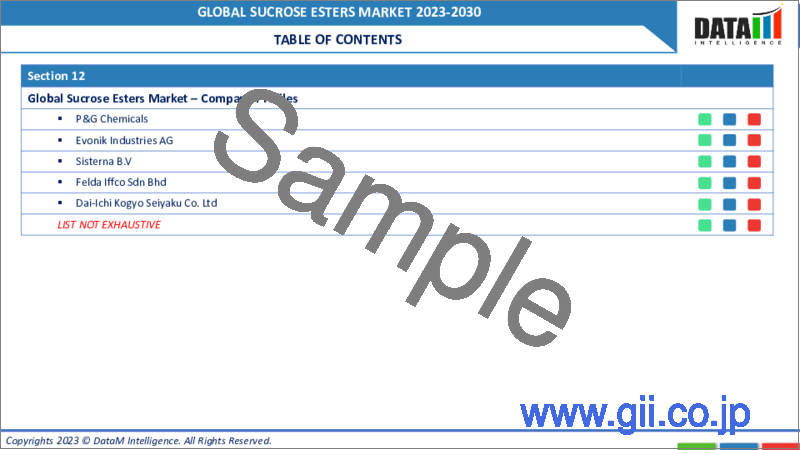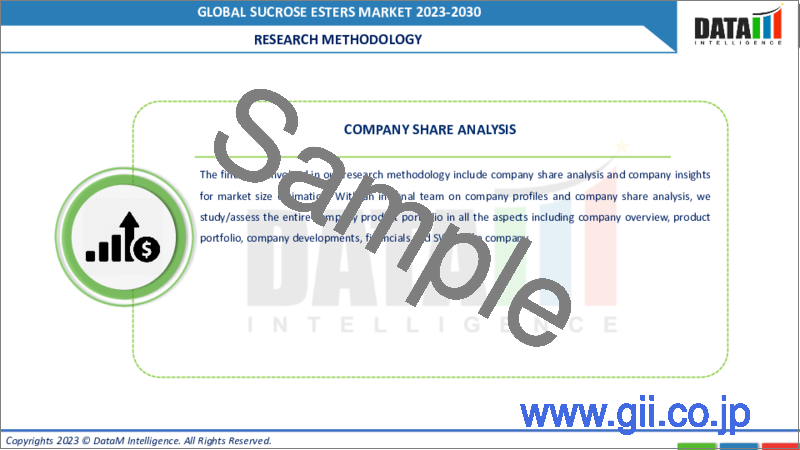|
|
市場調査レポート
商品コード
1146476
ショ糖脂肪酸エステルの世界市場-2022-2029Global Sucrose Esters Market - 2022-2029 |
||||||
|
● お客様のご希望に応じて、既存データの加工や未掲載情報(例:国別セグメント)の追加などの対応が可能です。 詳細はお問い合わせください。 |
|||||||
| ショ糖脂肪酸エステルの世界市場-2022-2029 |
|
出版日: 2022年10月31日
発行: DataM Intelligence
ページ情報: 英文 170 Pages
納期: 約2営業日
|
- 全表示
- 概要
- 目次
市場力学
乳製品、菓子類、ベーカリーへの需要が市場拡大の原動力
消費者の健康志向の高まり、可処分所得の増加、欧米型のライフスタイルへの嗜好、多忙なライフスタイルがもたらす肥満や慢性疾患の蔓延などにより、ベーカリーや菓子類に対する需要が増加しています。ベーカリー製品には、タンパク質との相互作用とデンプンとの相互作用という2つの利点があります。ショ糖脂肪酸エステルは、その化学構造上、小麦粉のタンパク質と親水性・疎水性双方で相互作用することができます。また、非イオン性であるため、小麦粉の成分であるアミロースと容易にうまく結合することができます。春になると、高容量、きめ細かなパン粉、柔らかな食感が得られます。また、糖の結晶化や安定性にも影響を与えます。ショ糖脂肪酸エステルを乳製品に添加すると、フレーバーリリースの向上、オーバーランの増加、微細な泡構造の形成、クリーミーな口当たりの実現、タンパク質の凝集の防止などの効果があります。
一方、ローション、クリーム、ファンデーションなどのパーソナルケア製品や化粧品には、乳化剤や溶媒としてショ糖脂肪酸エステルを使用するものが増えています。また、化粧品に保湿性や抗菌性を持たせることができます。また、天然素材やオーガニック製品を使用することが一般的になりつつあり、市場の拡大につながっています。
しかし、製品を市場に出すには、厳しいガイドラインのもと、難しい認可プロセスを通過しなければなりません。政府の規制、規則、承認プロセスへの干渉が、市場拡大の妨げとなっています。
地理的浸透度。
予測期間中、欧州が圧倒的なシェアを占める
欧州が世界のショ糖脂肪酸エステル市場で最大のシェアを占めているのは、消費者のライフスタイルや食生活の変化、可処分所得の増加、主要市場関係者による食品・飲料業界の継続的な技術革新がもたらすベーカリーや菓子類への需要増加のためです。例えば、IQF(Individual Quick Frozen)技術は、食品に大きな氷の結晶を残さないようにするために使用されています。この地域では、ペットフードの需要が高まっていることや、消費者の可処分所得が高いことも、市場拡大の要因となっています。この市場の主要企業のうち、BASF(ドイツ)、Evonik Industries(ドイツ)、Sisterna(オランダ)は、欧州のショ糖脂肪酸エステル需要に対応することに注力しています。欧州のショ糖脂肪酸エステル市場は、消費者のEU規格に対する意識の高まりから、メーカーのEU規格への対応意欲が高まっていることで拡大しています。
一方、アジア太平洋地域は、化粧品に対する消費者の意識が高く、身だしなみと美容が社会的交流と自尊心に与えるプラスの効果に重点を置くようになっているため、予測期間中、マーケティング担当者に有利な成長の機会を提供すると予想されます。中国は、健康上の利点に対する認識が高まっていることから、世界最大のショ糖脂肪酸エステル市場の1つにランクされています。
競合情勢。
業界には複数の既存参入企業と現地メーカーが存在するため、市場は断片的です。主要なキープレイヤーには、World Chem Industries、Croda International PLC、Mitsubishi Chemical Holdings Corporation、BASF SE、Alfa Chemicals、P&G Chemicals、Evonik Industries AG、Sisterna B.V, Felda Iffco Sdn Bhd、第一工業製薬、Co.Ltd.,Deutsche &Seiyaku Co.第一工業製薬株式会社これらの企業は市場に広く浸透し、強固な経営・財務体質を有しています。例えば、Croda Internationalは、2021年4月にフランスのAlban Muller Internationalの買収を発表し、オールナチュラルな有効成分や化粧品成分の選択肢を広げています。この買収により、クロダはパーソナルケア市場向けに環境に配慮した有効成分の品揃えを拡充します。また、クロダは、今回の買収により、植物原料業界における最先端の技術的進歩を利用することができます。その一つが、最もデリケートな有効成分をも保護する低エネルギー乾燥技術であるゼオドレーションです。クロダは、アルバン・ミュラーの世界な販売ネットワークと処方に関する専門知識を利用することで、アルバン・ミュラーの将来の成長を加速させることを期待しています。
COVID-19の影響世界のショ糖脂肪酸エステル市場に対するネガティブな影響
COVID-19が世界経済に与える影響としては、需給に直接影響を与える、市場やサプライチェーンを混乱させる、企業や金融市場に経済的影響を与える、の3つが主なものです。主要な食品は、食品メーカーによる生産量が減少しました。一方、健康全般を向上させる方法を模索する中で、免疫力を高める製品や糖分の少ない製品への需要が急増しています。COVID-19の大流行の結果、健康志向の消費者の多くは、低カロリーまたは砂糖不使用の食品に目を向けるようになりました。製造業者および製品処方者は、世界人口の健康意識の高まりと糖分低減ソリューションの高い需要により、ショ糖脂肪酸エステルの使用を開始しました。
ショ糖脂肪酸エステルの世界市場レポートでは、約61の市場データ表、57の図、170ページの構成で提供しています。
目次
第1章 調査手法と範囲
- 調査手法
- 市場の範囲
第2章 主な動向と発展
第3章 エグゼクティブサマリー
- 形態別市場内訳
- 機能別市場内訳
- アプリケーション別市場内訳
- 地域別市場内訳
第4章 市場力学
- 市場影響要因
- 促進要因
- 抑制要因
- ビジネスチャンス
- 影響分析
第5章 産業分析
- ポーターのファイブフォース分析
- バリューチェーン分析
- 特許分析
- 規制分析
第6章 COVID-19の分析
- COVID-19の市場分析
- COVID-19以前の市場シナリオ
- COVID-19の現在の市場シナリオ
- COVID-19の後、または将来のシナリオ
- COVID-19の中での価格ダイナミクス
- 需要-供給スペクトラム
- パンデミック時の市場に関連する政府の取り組み
- メーカーの戦略的取り組み
第7章 形状別
- 粉体
- 液体
- ペレット
第8章 機能別
- タンパク質とでんぷんの相互作用
- 抗菌性
- 糖の結晶化制御
- 乳化
- その他
第9章 用途別
- 食品
- パーソナルケア製品
- 洗剤・洗浄剤
第10章 地域別
- 北米
- 米国
- カナダ
- メキシコ
- 南米
- ブラジル
- アルゼンチン
- その他の南米地域
- 欧州
- ドイツ
- 英国
- フランス
- スペイン
- イタリア
- その他の欧州地域
- アジア太平洋地域
- 中国
- インド
- 日本
- オーストラリア
- その他アジア太平洋地域
- 中東・アフリカ地域
第11章 競合情勢
- 競合シナリオ
- 競合の戦略分析
- 市況/シェア分析
- M&A(合併・買収)分析
第12章 企業プロファイル
- World Chem Industries
- 企業概要
- 製品ポートフォリオと説明
- 主なハイライト
- 財務概要
- Croda International PLC
- Mitsubishi Chemical Holdings Corporation
- BASF SE
- Alfa Chemicals
- P&G Chemicals
- Evonik Industries AG
- Sisterna B.V
- Felda Iffco Sdn Bhd
- Dai-Ichi Kogyo Seiyaku Co. Ltd
第13章 DataM
Market Overview
From edible fatty acids, palm oil is used to esterify sucrose to create sucrose esters. In almost all food formulations, they can thus be used as emulsifiers. Esters of sucrose are created by the reaction of sucrose and fatty acid esters. Saturated fatty acids like behenic acid, myristic acid, palmitic acid, lauric acid, and myristic are used to create sucrose esters. Some sucrose esters' functions include stabilizing, emulsifying, defoaming, dispersing, preventing, and retrograding starch. The interesterification process is typically used to create sucrose esters; in this process, the fatty acids that are used to create the esters are already esterified. Emulsion technology-based processes, which are based on micro-emulsion technology, are another way to produce sucrose esters. Oil-in-water emulsifiers are sucrose esters with high HLB, while water-in-oil emulsifiers are sucrose esters with low HLB. The key factors driving the growth of the sucrose ester market are the rising preference for convenience foods, the rising demand for personal care products, and the multifunctionality of sucrose esters.
The global sucrose esters market was growing at a CAGR of 5.4% during the forecast period (2022-2029)
Market Dynamics: Demand for dairy, confectionery, and bakery goods drives market expansion
Due to rising health consciousness among consumers, rising disposable income, a preference for western lifestyles, and the prevalence of obesity and chronic diseases brought on by a busy lifestyle, there has been an increase in demand for bakery and confectionery products. It offers bakery products two advantages, namely protein interaction and starch interaction. Because of their chemical makeup, sucrose esters can interact with flour's proteins in both hydrophilic and hydrophobic ways. They can easily and successfully combine with amylose, a flour component, as they are also non-ionic. High volume, finer crumb, and increased tenderness are the outcomes over spring. They also have an impact on sugar crystallization and stability. When sucrose ester is added to dairy products, the flavor release is enhanced, overrun increases, fine foam structure forms, a creamy mouthfeel is produced, and protein flocculation is prevented.
On the other hand, more and more personal care and cosmetics products, including lotions, creams, and foundations, use sucrose esters as emulsifiers and solvents. Additionally, sucrose esters give personal care products moisturizing and anti-microbial qualities. Using natural and organic products is becoming more and more popular, which helps the market expand.
However, before a product can be introduced to the market, it must pass through a difficult approval process under strict guidelines. Government restrictions, rules, and meddling in the approval process continue to hamper market expansion.
Market Segmentation: Powdered sucrose ester segment accounted for the highest share in global sucrose esters market
It is widely used in baked goods, dessert icing, and sweets with fruit flavors. Sucrose esters in powdered form extend the shelf life of baked goods by minimizing the amount of water contaminated by microorganisms. To enhance the release of flavor and texture, powdered sucrose esters are also added to beverages with dairy as a base.
On the other hand, the food segment is expected to grow in the forecast period. The sucrose ester market grew due to consumers' shifting preferences, rising disposable income, and westernized eating habits, which also increased sales in the food and beverage sector. The food and beverage industry primarily uses sugar esters as emulsifiers and preservatives. Its use in dairy products is fueled by some characteristics, including emulsification, aeration, and protein protection. Its ability to stop protein flocculation and enhance flavor release are sucrose's two main benefits as a dairy product substitute. Sucrose esters can interact with dairy proteins because of their chemical makeup. This interaction makes dairy proteins more resistant to high temperatures, low pH, and destabilizing elements like alcohol and beta-glucan.
Geographical Penetration: Europe is the dominating region during the forecast period
Europe held the largest market share in the global sucrose ester market due to rising demand for bakery and confectionery goods brought on by changing consumer lifestyles and diets, rising disposable incomes, and ongoing innovation in the food and beverage industry by major market players. For instance, the Individual Quick Frozen (IQF) Technology is used to keep food products free of large ice crystals. The rising demand for pet food and the high consumer disposable income in this region are other factors driving market expansion. Among the major players in this market, BASF (Germany), Evonik Industries (Germany), and Sisterna (Netherlands) concentrate on meeting European demand for sucrose esters. The European sucrose esters market is expanding due to manufacturers' increased willingness to adhere to EU standards due to consumers' growing awareness of them.
On the other hand, because of the region's high level of consumer awareness of cosmetics products and the growing emphasis placed on the positive effects that personal grooming and beauty have on social interaction and self-esteem, the Asia Pacific is anticipated to present marketers with lucrative growth opportunities during the forecasted period. China ranks among the world's largest sucrose ester markets due to the rising awareness of health benefits.
Competitive Landscape:
There are several established participants in the industry and local manufacturers; hence, the market is fragmented. Some major key players include World Chem Industries, Croda International PLC, Mitsubishi Chemical Holdings Corporation, BASF SE, Alfa Chemicals, P&G Chemicals, Evonik Industries AG, Sisterna B.V, Felda Iffco Sdn Bhd, Dai-Ichi Kogyo and Seiyaku Co. Ltd. These players have extensive market penetration and strong operational and financial standing. For instance, Croda International announced the acquisition of France's Alban Muller International in April 2021 to broaden its selection of all-natural active and cosmetic ingredients. With this acquisition, Croda's assortment of environmentally friendly active ingredients for the personal care market is expanded. Through the combination, Croda will also access some of the most cutting-edge technological advancements in the botanical industry. One is Zeodration, a low-energy drying technique that protects even the most delicate active ingredients. By giving Alban Muller access to its global sales network and formulation expertise, Croda hopes to accelerate Alban Muller's future growth.
COVID-19 Impact: Negative impact on the global sucrose esters market
The three main ways that COVID-19 can impact the world economy are by directly affecting supply and demand, disrupting the market and supply chain, and having an economic impact on businesses and financial markets. Major food products were produced in less quantity by food manufacturers. On the other hand, there is a sharp rise in demand for immunity-boosting and less sugary products as people look for ways to improve their general health and well-being. As a result of the COVID-19 pandemic, most health-conscious consumers have turned to low-calorie or sugar-free foods. Manufacturers and product formulators started using sucrose esters due to the global population's growing health consciousness and high demand for sugar-reduced solutions.
The global sucrose esters market report would provide an access to approximately 61 market data tables, 57 figures and 170 pages
Table of Contents
Scope and Methodology
- 1.1. Research Methodology
- 1.2. Scope of the Market
2. Key Trends and Developments
3. Executive Summary
- 3.1. Market Snippet by Form
- 3.2. Market Snippet by Function
- 3.3. Market Snippet by Application
- 3.4. Market Snippet by Region
4. Market Dynamics
- 4.1. Market impacting factors
- 4.1.1. Drivers
- 4.1.2. Restraints
- 4.1.3. Opportunities
- 4.2. Impact analysis
5. Industry Analysis
- 5.1. Porter's five forces analysis
- 5.2. Value chain analysis
- 5.3. Patent Analysis
- 5.4. Regulatory Analysis
6. COVID-19 Analysis
- 6.1. Analysis of Covid-19 on the Market
- 6.1.1. Before COVID-19 Market Scenario
- 6.1.2. Present COVID-19 Market Scenario
- 6.1.3. After COVID-19 or Future Scenario
- 6.2. Pricing Dynamics Amid Covid-19
- 6.3. Demand-Supply Spectrum
- 6.4. Government Initiatives Related to the Market During Pandemic
- 6.5. Manufacturers Strategic Initiatives
7. By Form
- 7.1. Introduction
- 7.1.1. Market size analysis, and y-o-y growth analysis (%), By Form
- 7.1.2. Market attractiveness index, By Form
- 7.2. Powder *
- 7.2.1. Introduction
- 7.2.2. Market Size Analysis, US$ Million, 2020-2029 And Y-O-Y Growth Analysis (%), 2021-2029
- 7.3. Liquid
- 7.4. Pellets
8. By Function
- 8.1. Introduction
- 8.1.1. Market size analysis, and y-o-y growth analysis (%), By Function Segment
- 8.1.2. Market attractiveness index, By Function Segment
- 8.2. Protein & starch interaction *
- 8.2.1. Introduction
- 8.2.2. Market Size Analysis, US$ Million, 2020-2029 And Y-O-Y Growth Analysis (%), 2021-2029
- 8.3. Antimicrobial property
- 8.4. Controlled sugar crystallization
- 8.5. Emulsification
- 8.6. Others
9. By Application
- 9.1. Introduction
- 9.1.1. Market size analysis, and y-o-y growth analysis (%), By Application Segment
- 9.1.2. Market attractiveness index, By Application Segment
- 9.2. Food *
- 9.2.1. Introduction
- 9.2.2. Market Size Analysis, US$ Million, 2020-2029 And Y-O-Y Growth Analysis (%), 2021-2029
- 9.3. Personal Care Products
- 9.4. Detergents and Cleansers
10. By Region
- 10.1. Introduction
- 10.1.1. Market Size Analysis, And Y-O-Y Growth Analysis (%), By Region
- 10.1.2. Market Attractiveness Index, By Region
- 10.2. North America
- 10.2.1. Introduction
- 10.2.2. Key region-specific dynamics
- 10.2.3. Market Size Analysis, And Y-O-Y Growth Analysis (%), By Form
- 10.2.4. Market Size Analysis, And Y-O-Y Growth Analysis (%), By Function
- 10.2.5. Market Size Analysis, And Y-O-Y Growth Analysis (%), By Application
- 10.2.6. Market Size Analysis, And Y-O-Y Growth Analysis (%), By Country
- 10.2.6.1. U.S.
- 10.2.6.2. Canada
- 10.2.6.3. Mexico
- 10.3. South America
- 10.3.1. Introduction
- 10.3.2. Key Region-Specific Dynamics
- 10.3.3. Market Size Analysis, And Y-O-Y Growth Analysis (%), By Form
- 10.3.4. Market Size Analysis, And Y-O-Y Growth Analysis (%), By Function
- 10.3.5. Market Size Analysis, And Y-O-Y Growth Analysis (%), By Application
- 10.3.6. Market Size Analysis, And Y-O-Y Growth Analysis (%), By Country
- 10.3.6.1. Brazil
- 10.3.6.2. Argentina
- 10.3.6.3. Rest of South America
- 10.4. Europe
- 10.4.1. Introduction
- 10.4.2. Key Region-Specific Dynamics
- 10.4.3. Market Size Analysis, And Y-O-Y Growth Analysis (%), By Form
- 10.4.4. Market Size Analysis, And Y-O-Y Growth Analysis (%), By Function
- 10.4.5. Market Size Analysis, And Y-O-Y Growth Analysis (%), By Application
- 10.4.6. Market Size Analysis, And Y-O-Y Growth Analysis (%), By Country
- 10.4.6.1. Germany
- 10.4.6.2. U.K.
- 10.4.6.3. France
- 10.4.6.4. Spain
- 10.4.6.5. Italy
- 10.4.6.6. Rest of Europe
- 10.5. Asia Pacific
- 10.5.1. Introduction
- 10.5.2. Key Region-Specific Dynamics
- 10.5.3. Market Size Analysis, And Y-O-Y Growth Analysis (%), By Form
- 10.5.4. Market Size Analysis, And Y-O-Y Growth Analysis (%), By Function
- 10.5.5. Market Size Analysis, And Y-O-Y Growth Analysis (%), By Application
- 10.5.6. Market Size Analysis, And Y-O-Y Growth Analysis (%), By Country
- 10.5.6.1. China
- 10.5.6.2. India
- 10.5.6.3. Japan
- 10.5.6.4. Australia
- 10.5.6.5. Rest of Asia Pacific
- 10.6. Middle East and Africa
- 10.6.1. Introduction
- 10.6.2. Key Region-Specific Dynamics
- 10.6.3. Market Size Analysis, And Y-O-Y Growth Analysis (%), By Form
- 10.6.4. Market Size Analysis, And Y-O-Y Growth Analysis (%), By Function
- 10.6.5. Market Size Analysis, And Y-O-Y Growth Analysis (%), By Application
11. Competitive Landscape
- 11.1. Competitive scenario
- 11.2. Competitor strategy analysis
- 11.3. Market positioning/share analysis
- 11.4. Mergers and acquisitions analysis
12. Company Profiles
- 12.1. World Chem Industries *
- 12.1.1. Company Overview
- 12.1.2. Product Portfolio and Description
- 12.1.3. Key Highlights
- 12.1.4. Financial Overview
- 12.2. Croda International PLC
- 12.3. Mitsubishi Chemical Holdings Corporation
- 12.4. BASF SE
- 12.5. Alfa Chemicals
- 12.6. P&G Chemicals
- 12.7. Evonik Industries AG
- 12.8. Sisterna B.V
- 12.9. Felda Iffco Sdn Bhd
- 12.10. Dai-Ichi Kogyo Seiyaku Co. Ltd
- List not Exhaustive*
13. DataM
- 13.1. Appendix
- 13.2. About us and services
- 13.3. Contact us




